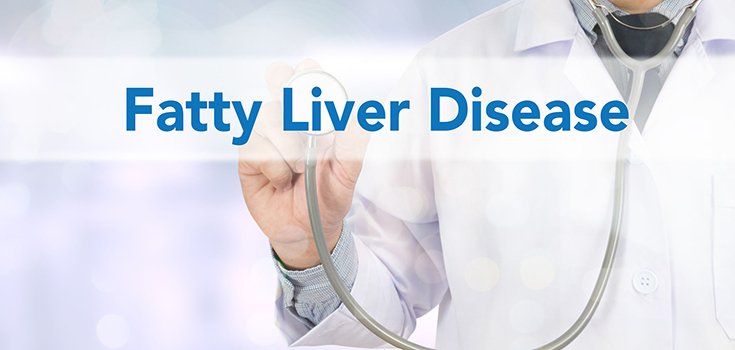Western Diet Found to Increase Risk of Fatty Liver Disease

Between 30-40% of American adults have nonalcoholic fatty liver disease (NAFLD), a condition with no visible signs that rarely causes symptoms. Despite its near-invisibility, NAFLD raises the risk of heart disease, diabetes, cirrhosis, and liver cancer. What’s more, a recent study suggests that people with a high-risk variant of the PNPLA3 gene are much more likely to have NAFLD if they’re obese than if they’re thin. [1]

NAFLD actually refers to several stages of disease. Most people have a form of the disease known as “fatty liver,” in which more than 5% of the liver is made up of fat cells. It is often related to obesity, poor diet, and a sedentary lifestyle.
A poor diet and a sedentary lifestyle are the natural precursors to obesity. And in people with the gene variant, obesity may be a precursor to a fatty liver.
Study co-author Jonathan Cohen, professor of internal medicine at UT Southwestern Medical Center, explains:
“If you are obese and lack the variant, then there is a good chance that you won’t have excess fat in your liver. But if you are obese and do have the variant—particularly if you have two copies of the variant—you are very likely to have excess fat in your liver.” [1]
Read: 10% of U.S. Teens Have Nonalcoholic Fatty Liver Disease
Oddly enough, in most people with NAFLD, liver problems like inflammation and scarring aren’t much of a problem. Insulin resistance – which can lead to type 2 diabetes and cardiovascular disease – is much more of a concern.
However, an advanced form of NAFLD, called nonalcoholic steatohepatitis, or NASH, affects 3% to 12% of U.S. adults. Dr. Jaideep Behari, associate professor and founder of the University of Pittsburgh Medical Center’s Fatty Liver Clinic, says:
“This form is characterized by inflammation and cell injury. Cells are dying and there’s progressive scarring, which can lead to cirrhosis and even liver cancer.” [1]
Research suggests that people with diabetes, high blood pressure, high cholesterol, and excess fat around their middle are more at risk for NASH; but researchers say it isn’t clear why some people develop the more advanced form of NAFLD, while others never do. Some people actually alternate between the two forms of the disease.
“Sometimes people exercise more and eat a healthier diet while at other times they’re being less healthy. They’re going back and forth with their lifestyle, and the condition of their liver is going back and forth as well.” [1]
Not everyone who has NAFLD is obese, either. According to Behari, doctors are seeing an increase in people with normal body weight presenting with the disease. This is referred to as “lean fatty liver.” Certain ethnic groups with lower BMIs have a greater chance of developing lean fatty liver, too, including people of Asian descent.
Dr. Hobbs, Director of the McDermott Center, a Howard Hughes Medical Institute (HHMI) Investigator, and a Professor of Internal Medicine and Molecular Genetics, says that all obese people who have NAFLD can benefit from weight loss, but “those who have the risk allele in PNPLA3 are likely to benefit more.” [2]
A “Western-Style” Diet may Increase the Risk of NAFLD
Researchers used participants in the Rotterdam Study to examine the dietary components of NAFLD in elderly adults. They presented their findings in April to the International Liver Congress in Amsterdam.
The team collated data from 3,440 people, of which 30% were considered lean and the remaining 70% were considered overweight. The participants’ diets were assessed using a 389-item food frequency questionnaire.
Using an ultrasound, researchers detected NAFLD in 35% of the participants.

Total protein intake was linked to an increased risk of NAFLD, which was primarily driven by animal protein. The link was particularly strong in obese individuals. Even after researchers adjusted for metabolic factors, animal protein – but not total protein – remained a significant risk factor.
Dr. Louise Alferink says:
“The results from this study demonstrate that animal protein is associated with NAFLD in overweight elderly people. This in line with a recently proposed hypothesis that a Western-style diet, rich in animal proteins and refined food items, may cause low-grade disturbances to the body homeostasis, glucose metabolism, and acid-based balance.
Another interesting finding is that, although current guidelines advise against foods containing fructose, such as soda and sugar, our results do not indicate a harmful association with mono- and disaccharides with NAFLD per se. In fact, we even found a slight beneficial association, which was attenuated when adjusted for metabolic factors.” [3]
Glucose is a monosaccharide, and sucrose is a disaccharide. Simply put, they are naturally occurring sugars. [4]
Read: High Fructose Corn Syrup May Promote Nonalcoholic Fatty Liver Disease
The authors believe this slight beneficial association might be because of healthy food items in the mono- and disaccharide food groups, such as antioxidant-rich fruits and vegetables. [3]
So, at the end of the day, the advice for avoiding and/or improving conditions like NAFLD and NASH may end up sounding very familiar: Consume less meat, eat more fruits and vegetables, and stay away from processed food and added sugar.
A vegan or vegetarian diet is one way to accomplish that. A Mediterranean diet – repeatedly shown in studies to be one of the healthiest eating patterns – may also help, for people who don’t want to totally give up meat.
Says Behari:
“For the majority of patients, lifestyle modification is way more effective than any drug. All of these chronic disorders—fatty liver, diabetes, heart disease—share an underlying metabolic component, and the same common-sense healthy living principles apply for all of them.” [1]
Sources:
[1] Time
[2] Science Daily
[4] Study.com
